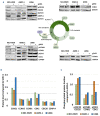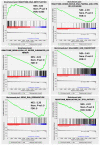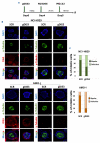DIS3 depletion in multiple myeloma causes extensive perturbation in cell cycle progression and centrosome amplification
- PMID: 37439377
- PMCID: PMC10772536
- DOI: 10.3324/haematol.2023.283274
DIS3 depletion in multiple myeloma causes extensive perturbation in cell cycle progression and centrosome amplification
Abstract
DIS3 gene mutations occur in approximately 10% of patients with multiple myeloma (MM); furthermore, DIS3 expression can be affected by monosomy 13 and del(13q), found in roughly 40% of MM cases. Despite the high incidence of DIS3 mutations and deletions, the biological significance of DIS3 and its contribution to MM pathogenesis remain poorly understood. In this study we investigated the functional role of DIS3 in MM, by exploiting a loss-of-function approach in human MM cell lines. We found that DIS3 knockdown inhibits proliferation in MM cell lines and largely affects cell cycle progression of MM plasma cells, ultimately inducing a significant increase in the percentage of cells in the G0/G1 phase and a decrease in the S and G2/M phases. DIS3 plays an important role not only in the control of the MM plasma cell cycle, but also in the centrosome duplication cycle, which are strictly co-regulated in physiological conditions in the G1 phase. Indeed, DIS3 silencing leads to the formation of supernumerary centrosomes accompanied by the assembly of multipolar spindles during mitosis. In MM, centrosome amplification is present in about a third of patients and may represent a mechanism leading to genomic instability. These findings strongly prompt further studies investigating the relevance of DIS3 in the centrosome duplication process. Indeed, a combination of DIS3 defects and deficient spindle-assembly checkpoint can allow cells to progress through the cell cycle without proper chromosome segregation, generating aneuploid cells which ultimately lead to the development of MM.
Figures








References
-
- Morgan GJ, Walker BA, Davies FE. The genetic architecture of multiple myeloma. Nat Rev Cancer. 2012;12(5):335-348. - PubMed
-
- Boyle EM, Ashby C, Tytarenko RG, et al. . BRAF and DIS3 mutations associate with adverse outcome in a long-term follow-up of patients with multiple myeloma. Clin Cancer Res. 2020;26(10):2422-2432. - PubMed
Publication types
MeSH terms
Substances
Grants and funding
LinkOut - more resources
Full Text Sources
Medical
Molecular Biology Databases

